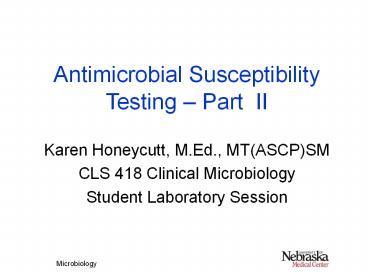Antimicrobial Susceptibility Testing - PowerPoint PPT Presentation
Title:
Antimicrobial Susceptibility Testing
Description:
Antimicrobial Susceptibility Testing Part II ... Enterococcus sp. Synergy Screen Test synergy with high level aminoglycoside gentamicin 500 ug/ml ... – PowerPoint PPT presentation
Number of Views:439
Avg rating:3.0/5.0
Title: Antimicrobial Susceptibility Testing
1
Antimicrobial Susceptibility Testing Part II
- Karen Honeycutt, M.Ed., MT(ASCP)SM
- CLS 418 Clinical Microbiology
- Student Laboratory Session
2
MIC Microdilution
Antimicrobial Susceptibility Testing - MIC
- Commercial
- Antibiotic at various concentrations
- Inoculate with standardized inoculum
- MIC
- Interpret (NCCLS)
3
MIC Microdilution
Antimicrobial Susceptibility Testing - MIC
Growth control Sterility control MIC ug/ml
Ampicillin 8.0 16.0 32.0 gt32.0
Piperacillin 16.0 32.0 64.0 128.0 128.0
Aztreonam 8.0 16.0 32.0 lt8.0
4
MIC Agar Dilution
Antimicrobial Susceptibility Testing - MIC
R resistant controlS susceptible controlA,
B, C, D isolates of S. aureus
R resistant controlS susceptible controlA
resistant (MRSA) B, C, D susceptibleisolates
of S. aureus
5
Detection of MRSA
Antimicrobial Susceptibility Testing - MRSA
- Methicillin R S. aureus or multi-drug R
- Beta-lactamase susceptible penicillins
- penicillin, ampicillin
- 95 of all S. aureus R to these penicillins
- Beta-lactamase resistant penicillins
- oxacillin, methicillin, nafcillin
- drug of choice to treat Staphylococcus infections
- Oxacillin is the representative drug tested for
the penicillinase R penicillins
6
Detection of MRSA
Antimicrobial Susceptibility Testing - MRSA
- If resistant to oxacillin, then MRSA
- MRSA is resistant to all penicillinase-resistant
penicillins - oxacillin, methicillin, nafcillin
- Also resistant to all beta-lactam antibiotics
- Drug of choice becomes vancomycin
7
Detection of MRSA
Antimicrobial Susceptibility Testing - MRSA
- Heteroresistant colonies
- within one colony S R strains
- R strains grow best at
- 33 to 35 C
- 2-4 NaCl in media
- pH 7.2 - 7.4
- Use direct inoculum (for all Staphs) - dont grow
up to turbid suspension
8
Detection of Vancomycin R Enterococci
Antimicrobial Susceptibility Testing - VRE
- Vancomycin R Enterococcus sp. (E. faecium)
- Very difficult to treat
- No standard treatment protocol
- Usually confirmed by 2 methods (MIC, agar
dilution, K-B) - Incubate a full 24 hours before interpretation is
S (refer to manufacturers protocol)
9
Susceptibility Testing Enterococcus sp.
Antimicrobial Susceptibility Testing
- Systemic infections (blood, body fluids, wounds,
etc.) treat with cell wall active antibiotic and
aminoglycoside - Synergistic
- break down cell wall
- aminoglycoside to ribosome
10
Susceptibility Testing Enterococcus sp.
Antimicrobial Susceptibility Testing
- Synergy Screen
- Test synergy with high level aminoglycoside
- gentamicin 500 ug/ml
- streptomycin 1000 ug/ml
- If S to penicillin and high level
aminoglycoside then should be synergistic - Penicillin S
- Streptomycin Synergy S
- Gentamicin Synergy S
11
Susceptibility Testing Enterococcus sp.
Antimicrobial Susceptibility Testing - VRE
- Penicillin S Strep Syn S Gent Syn R
- Penicillin synergistic w/ Streptomycin
- Penicillin R Vancomycin S Strep Syn S
Gent Syn S - Vancomycin synergistic w/Streptomycin Gentamcin
- Penicillin R Vancomycin S Strep Syn R
Gent Syn R - No synergistic response
12
Streptococcus pneumoniae screen for penicillin
susceptibility
Antimicrobial Susceptibility Testing S.
pneumoniae
- Detect resistance to penicillin
- Screen K-B with oxacillin on MHA w/5 sheep
blood - lt 20 mm zone presumptive evidence of resistance
to penicillin
13
Beta-lactamase Test
Antimicrobial Susceptibility Testing
- Nitrocefin (yellow) changes color (red) when
beta-lactam ring hydrolyzed - Nitrocefin disc most sensitive method
- Reaction time varies
14
Beta-lactamase Test
Antimicrobial Susceptibility Testing
- Haemophilus influenzae
- Anaerobes (ID)
- Staphylococcus sp. (if test S to penicillin,
ampicillin)
15
Detection of specific resistance mechanisms
Antimicrobial Susceptibility Testing
- MRSA Detection of PBP2a rapid latex
agglutination test detects the altered protein
encoded for by the mecA gene - Genotypic methods detection of genes or
plasmids encoding for resistance at the molecular
level
16
Predictable Patterns
Antimicrobial Susceptibility Testing - Patterns
- If Gram-positive bacteria, then S to vancomycin
- If beta-hemolytic Streptococci, then S to
penicillin - Pg 7 of notes

